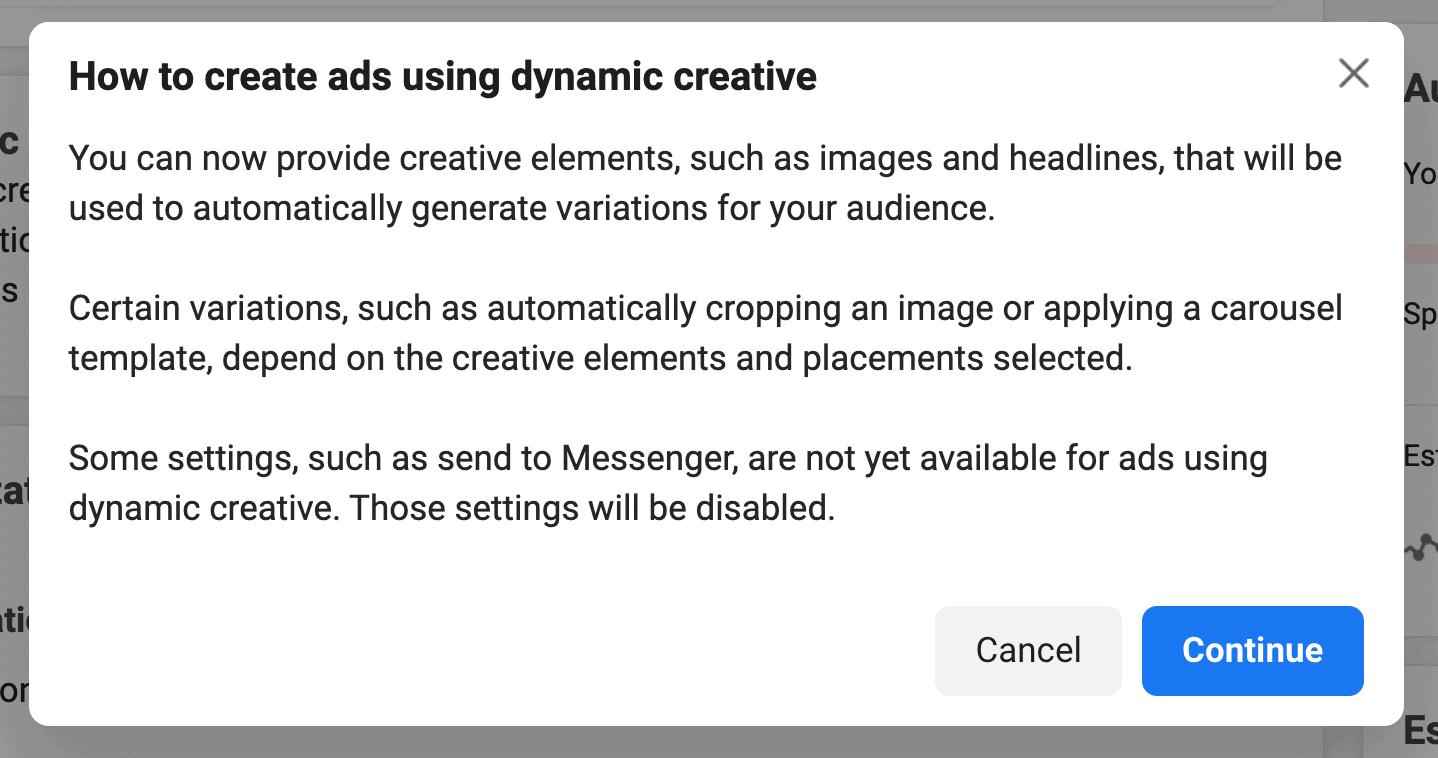Continue with the proven strategies for scaling your Facebook ads. Craving greater customer acquisition through your Facebook campaigns? Searching for a proven framework for scaling your Facebook ads? Within this article, unlock a comprehensive three-step strategy to amplify your business outcomes using Facebook ads.
#2: Create the 3-2-2 Content for Facebook Ads
In the One Campaign strategy, the next crucial step is to develop content that effectively reaches your target audience and drives results. Broad targeting aids in maintaining a low CPM, while quality content influences your cost per action (CPA).
To accomplish this, you’ll leverage the dynamic creative option in Facebook Ads, allowing the Facebook algorithm to contribute to the process. By employing the 3-2-2 method, you’ll identify the most impactful content and optimize its performance.
How to Maximize Your Facebook Campaigns with Dynamic Creative
When setting up a new ad set in your Facebook campaign, take advantage of the dynamic creative feature. This time-saving option allows you to input multiple versions of creative elements such as ad copy, headlines, descriptions, and calls to action (CTAs). The ad algorithm will then test different combinations to determine the most effective format, layout, and content that resonates with your target audience.
By using dynamic creative, you can avoid the labor-intensive task of creating numerous ad versions manually. Instead of splitting your budget and guessing which ads will perform best, you can focus your spending on a single ad set and let the algorithm handle the optimization.
The 3-2-2 Method: Optimizing Dynamic Creative
Now, let’s explore what to include in your dynamic creative ad set:
- 3 different versions of ad creative
- 2 different versions of the primary text
- 2 different headlines
With this configuration, the dynamic creative algorithm will generate 12 unique ad variations by testing different combinations of creative elements, primary text, and headlines.
You may have noticed that we’re not testing variations on the CTA. That’s because, in many cases, the CTA text has minimal impact on Facebook ads. Users already understand they can tap on a post for more information, so overly focusing on the CTA can distract from the overall content.
Tips for Creativity
Now that we’ve covered the scientific aspect, let’s delve into the details of your ad creative and copy. How can you ensure your content is compelling and performs well in your ads?
Consider the following tips to set yourself up for success:
- Define your ideal: Start by envisioning your ideal customer or identifying your most effective marketing angle. Craft your content to align with this vision.
- Learn from other channels: Seek inspiration from your successful email campaigns, engaging product descriptions, impactful social media posts, persuasive landing pages, and engaging organic content. Analyze what resonates with your audience and incorporate those elements.
- Choose one format: Instead of combining both images and videos, focus on one media format per ad set. This approach allows for clearer results and saves valuable time.
- Optimize for placements: Tailor your content to the specific placements you’re targeting. If you aim to appear in the Reels feed, create captivating vertical videos. For the Facebook home page, design eye-catching image carousels. Customize your content based on your desired placements.
By implementing these strategies, you can develop compelling creative that resonates with your audience and maximizes the effectiveness of your ads.
#3: Utilize the Scientific Method to Test Ads
With your ad set in place, featuring the 3-2-2 content and leveraging dynamic creative, it’s time to move on to the next crucial step: testing!
Embrace the scientific method as you conduct tests on your ad sets and harness the insights gained to further enhance your Facebook Ads strategy, achieving optimal scale and impact.
The Ad Testing Process
In case you need a refresher on the scientific method, here’s how it applies to testing ads.
You start with a “control” ad set that remains unchanged. Then, you introduce “variable” ad sets that include new concepts and creative elements. Both the control and variable ad sets are run simultaneously, and the results are compared to determine if the new ideas outperform the original.
In the One Campaign strategy, you have one control ad set and two variables, allowing for comprehensive testing without overwhelming the process or losing track of data. The control ad set consists of successful past posts, while the variable ad sets feature dynamic creative tests with 3-2-2 content.
The objective? To create strategy for scaling your Facebook ads that match or even surpass the success of the control ad set.
Interpreting Your Results
To analyze your ads effectively, it’s important to break things down. Access the analytics for your variable ad sets, navigate to Delivery, and separate them into distinct dynamic creative elements. This allows you to not only evaluate the overall performance of the ads but also determine which specific versions were the most successful.
For more comprehensive data, you can utilize the Preview Facebook Post Comments feature to gauge the engagement levels of each version, indicated by the Estimated Action Rate.
Next, consider your budget:
If a particular ad version received no spend, it indicates poor performance as the Facebook algorithm deemed it unworthy of investment. If an ad version garnered significant spend and impressions but failed to generate conversions, adjustments to your content are necessary. You’re reaching people, but not the right audience. Rectify this before it adversely affects your standing with the algorithm. If an ad version achieved ample spend, impressions, and conversions, you’ve discovered a winning ad. Congratulations! Usually, the dynamic creative option will yield one or two winners along with less successful versions. Discard the underperforming posts and focus on the best ones.
What’s the Next Step?
Once you have a winning ad, return to your control ad set and add the post ID to incorporate it. This ensures that the new winner remains in your control ad set, driving conversions and strengthening your relationship with the algorithm.
Then, promptly resume creating new tests.
By maintaining this pace, you’ll achieve consistent and reliable results. Moving faster would yield less useful outcomes, while moving slower would mean missing out on scaling opportunities. The One Campaign strategy for scaling Facebook Ads offers a perfect balance for sustained growth without sacrificing control.


